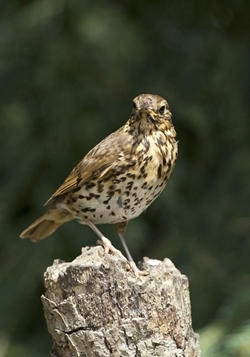Song thrush
 Early to rise and likes to repeat itself!
Early to rise and likes to repeat itself!
It was a grey January Monday morning as I drove to GWCT headquarters this week, and I realised that February had quickly crept up on me, which got me to thinking what species I would feature for this month’s instalment, but surprisingly the journey didn’t give me much inspiration.
However, as I got out of the car and made my way down to the walled garden to see my colleagues in the Research department, there was a song thrush (Turdus philomelos) singing loud and proud, perched high up in a tree and I thought, that’s it, the song thrush for February!
What could be more fitting as the Big Farmland Bird Count starts this month, 3-19 February, and is in its tenth year! So here we are...
From a very young age I have had an insatiable curiosity for nature. No wonder it has led me to where I am now in my career, and I remember being woken up regularly as a child by a very distinctive call at dawn, which used to drift though my open bedroom window in late winter/early spring. I would clamber up and look out the window at the tallest oak tree in the garden to see if I could see the culprit, but I could never make it out. But even though I couldn’t see it, I knew it was a song thrush. As their name suggests, song thrushes have quite a distinctive song.
They are one of the earliest birds to start singing in the morning, getting going about 3am, and then again at dusk. They start singing in late winter and continue right through to July, with a loud and very clear song, which does vary from bird to bird. However, the song has a series of repeated phrases sung one after another, which distinguishes itself from a singing blackbird or mistle thrush.
(The song of the mistle thrush is somewhere between a song thrush and a blackbird, with repeated phrases worked into more of an ongoing melody that stops and starts. It’s melancholier and more slurred than a blackbird, almost drunk-sounding, and louder, and they have a habit of singing in all weathers, which is where their old name of ‘stormcock’ comes from. Their call is a very distinctive loud rattle, like a football rattle.)
The song thrush is a member of the thrush family, which includes blackbirds, redwings and fieldfares and in comparison to other thrushes, the song thrush is medium-sized (slightly smaller than a blackbird) and timid. They have a slim build, around 23cm in length, with a wingspan of 34cm and weighing 83g with tawny brown backs, darker cheeks, and creamy white and buff fronts, covered in speckled drop-shaped dark spots. It is smaller and a warmer brown than the mistle thrush, which they are commonly mistaken for, and lacks the white eye stripe and red flank patches of the redwing.
It is a familiar resident songbird to many and a regular visitor to both garden and parks, woodland, and farmland pasture and hedgerows – anywhere with trees and bushes where they can search out invertebrates in the summer and fruit and berries in winter. They’ll happily take garden offerings of bruised apples and mealworms, but as I said, they’re timid and you’ll often see them being bullied away by blackbirds and other members of the thrush family. Song thrushes are widespread throughout Europe, and as far east as Siberia. Northern populations are migratory, heading to Africa, whereas our song thrushes tend to be residents – some are migratory, but many of our song thrushes hold on to the same territories over the winter, so can be seen year-round.
If you’re anything like me when you’re out and about, always looking out for tracks and signs of wildlife, you might have noticed piles of smashed fragments of snail shells circling a sticky stone. This is a tell-tale sign that you have a song thrush around. Song thrushes are famous for their habit of bashing snails on a stone, or an ‘anvil’ as it is called, to crack open the shells of one of their favourite food sources: the snail.
In the spring and summer, song thrushes can often be seen on the ground looking for worms and beetles. Their movements are quite blackbird-like, and they have a habit of standing quite upright and cocking their heads. They’re strong fliers and like to sing high up on prominent branches and breed quite early in spring, from March until April, often producing up to three broods of up to five blue, spotty eggs in a cup-shaped nest in trees close to the trunk.
While the song thrush was once one of our most common birds, it is now unfortunately an amber-listed species of conservation concern. The species has declined significantly since 1970. Here are a few tips to increase numbers on your land and in your garden.
- Aim to cut farm and garden hedges on rotation to boost berry production and protect nest sites from hedge production.
- Establish areas of wild bird crops. Kale is particularly favoured for foraging.
- Aim to create extended margins in arable and grassland fields to increase feeding opportunities.
- Try to leave damp areas in field corners and gardens to maintain insect populations.
- Song thrushes are vulnerable to molluscicides, so a consultation with your agronomist is advised for best practice for slug control to prevent poisoning.
- Take part in the Big Farmland Bird Count to monitor your success!
Megan Lock
Advisory
Photo credit: David Mason